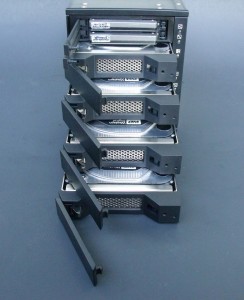Data security is an issue for all users these days. Losing a single drive worth of pictures, documents and videos can be just as devastating as a house fire, tornado, or even a hurricane for many people. It will remain to be that those things, unable to be replaced, are most missed by any victim of mother nature, or the whims of chance.
Our report today is going to be on a product that we believe can tackle this concern. The RAIDon iR2940-6S-S2D RAID Enclosure is an item that just may be able to secure memories and, at the same time, enable this through a very easily understood interface.
INTRODUCTION
Furniture, televisions and appliances can be replaced easily but no amount of insurance can replace the video of the birth of a child, the first steps, or the valued pictures of loved ones who have passed on. These cannot be retaken and are the truly important things in life.
 Most young adults today entering college have probably never taken a roll of film to be developed or used a physical form of media such as a VCR tape to store their video on. These things are all digital, stored, handled and processed via the home computer. Important pictures are snapped on digital cameras and cell phones and then transferred to the computer.
Most young adults today entering college have probably never taken a roll of film to be developed or used a physical form of media such as a VCR tape to store their video on. These things are all digital, stored, handled and processed via the home computer. Important pictures are snapped on digital cameras and cell phones and then transferred to the computer.
With the push towards digital everything, users can easily find their entire life placed on a disk. For most users, this is akin to placing all of their eggs in the same basket. As any storage veteran knows, keeping a single copy of any type of data is a foolhardy proposition.
For casual users, things such as parity raid sets and data duplication are just another term for something that they have little to no desire to understand. Users want simplicity, and simplicity is exactly what a normal user needs when it comes to a comprehensive data protection plan.
RAIDon has come up with the perfect device to help tackle one layer of data security, and that is typically the very ‘first’ layer of duplication. The very drive that the data is first copied onto.
The primary disk of any operating system is usually the most likely to fail as it is simply used and utilized more than any other. Backups and other static forms of data storage are usually more stable as they generally just sit there, waiting for the next batch of data to be backed up to them.
This is where parity RAID sets and mirroring can come into play for the normal user. But what exactly is mirroring, parity and RAID?
RAID is using more than one disk to store the same data at the same time, with the purpose of duplication, redundancy and safety, using various approaches.
 Mirroring is simple, you will have two disks that operate as one. Any data that is written to the drive will be duplicated across both disks. In this manner, the user has two copies of all the data, contained on separate drives. If one drive were to fail, then the other would still have the exact same data intact.
Mirroring is simple, you will have two disks that operate as one. Any data that is written to the drive will be duplicated across both disks. In this manner, the user has two copies of all the data, contained on separate drives. If one drive were to fail, then the other would still have the exact same data intact.
Using RAID sets with parity is more challenging. Spread across each drive is a set of parity data, which can be used to reconstruct the data if one of the member disks fails. This allows the user what is described as ‘fault tolerance’ in case one of their drives were to fail.
The unit will continue to function, and no data will be lost. Once another disk is inserted into the RAID, the data will be recreated onto that disk, and continue functioning normally. There are several levels of parity based RAID, but the most common is RAID 5, which is utilized on the device that we will be reviewing today.
RAID 5 can be a daunting level of protection for the average user, and this is exactly what RAIDon is looking to simplify for us today. Taking this advanced form of data protection and packaging it in an easy to use device for the normal user is very challenging, so lets find out how RAIDon approaches the challenge.
 The SSD Review The Worlds Dedicated SSD Education and Review Resource |
The SSD Review The Worlds Dedicated SSD Education and Review Resource | 